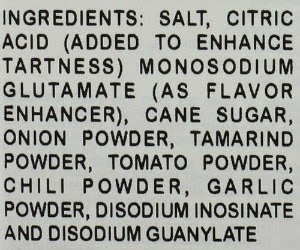Sinigang is one of those really healthy, traditional foods screwed over by modern times. Once people started to hurry up and run out of time, they started reaching for those admittedly handy, time-saving packets of sinigang mix to save themselves the trouble of making the soup base from scratch. Or I should say we, because I’ve done it myself. But this is what we bought for the sake of convenience:
Thankfully, the fix for this is easy. Just follow our grandmothers’ lead and make sinigang the old fashioned way!
Or, you know, close to it. I suppose I could have bought unripe tamarind fruit and boiled it, and mashed it, and strained it – rinse and repeat – like they used to do. But I found some tamarind preserve that came in plastic-wrapped blocks in a nearby Asian grocery store and decided to use that instead. Saved me a step or two. (Others have used tamarind concentrate and saved themselves even more time, still without resorting to any MSG-laden sinigang mix. You are welcome to use their technique, too.)
Sinigang is more typically made with pork or prawns, but I happened to have some frozen salmon filets in my freezer, so that’s the way I went.
Translations
Sinigang (see-neeh-gahng): sour soup or stew (usually tamarind-flavored) cooked with pork, prawns, or fish, along with boatload of veggies
Patis (pah-tis): fish sauce
Kangkong (kahng-kong): water spinach, a semi-aquatic tropical plant grown as a veggie
Ingredients
For the broth –
- tamarind preserve (only ingredient: unripe tamarind)
- 5 cups of water
- 1 teaspoon minced ginger
- 1/2 teaspoon ground black pepper
- 2 tablespoons patis
For the soup –
- 2 salmon filets
- 1 tomato, quartered
- half a small onion, coarsely chopped
- 5-6 cups of other veggies, such as bok choy, sliced Chinese eggplant, sliced daikon radish, and sitaw (long string beans) cut in 6-8 inch lengths (see photo below). You can also use other veggies such as okra, cubed taro, and kangkong (water spinach), and you can add hot chili finger pepper or horseradish if you like it sour and hot.
Instructions
For the broth –
- Boil the water in a pot and add some tamarind preserve. The amount is really variable, dependent on how sour the tamarind is and how sour you want the broth to be. I like ending up with a broth that is mouth-puckeringly sour, which in this case meant about 5-6 tablespoons of the tamarind preserve I bought. You can adjust the sourness as needed, and keep in mind the tartness also gets somewhat diluted later when you add the veggies.
- Add the patis, ginger, and pepper. Lower the heat and simmer for 30 minutes.
- Adjust the taste, adding more water or more tamarind preserve to modulate the sourness, and add more patis or pepper to taste if necessary. When you have it the way you want it, strain the broth in a fine mesh strainer and discard the tamarind residue.
For the soup –
- Return the broth into the pot and bring back to a boil. Add your tomato and onion. Then add the veggies that take the longest to cook; in this case, the radish and the long beans. Lower the heat and let simmer for 10 minutes. (Side note: if making pork sinigang, add the pork at this point and lengthen the simmering time to about 45 minutes.)
- Add the salmon filets, stirring the pot to make sure they are submerged. Simmer an additional 5 minutes.
- Add the eggplant and bok choy. Simmer an additional 3-4 minutes.
- Ladle the soup into a bowl and soup’s on!
Makes 2 servings. You can have the soup by itself, if you like, but you’ll probably want something bland to blunt the tartness. Normally it would be rice, but for Whole30, try cauliflower rice as your side dish. Have a small saucer of patis on the side as a dipping sauce for the fish and veggies.
How this is Whole30
No sinigang packet means no MSG or other preservatives you need a Chemistry degree to decipher. End result? A whole lot of healthy sour goodness!
- About Whole30



where did you get the tamarind preserve?
ReplyDeleteAsian grocery store.
Delete